
Birt is a lunar impact crater located in the eastern half of the Mare Nubium and west of the Rupes Recta. It was named after British selenographer William R. Birt.
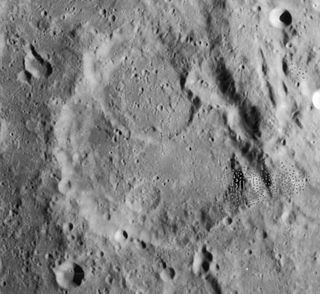
Catharina is an ancient lunar impact crater located in the southern highlands. It was named after Saint Catherine of Alexandria. It lies in a rugged stretch of land between the Rupes Altai scarp to the west and Mare Nectaris in the east. To the west-northwest is the crater Tacitus, and the lava-flooded Beaumont lies to the east along the shore of Mare Nectaris. To the south-southeast is Polybius.

Väisälä is a tiny lunar impact crater located on a rise in the Oceanus Procellarum. Sharing the same continental island are the brilliant crater Aristarchus to the south-southeast and Herodotus to the south-southwest. Väisälä lies just to the west of the Rupes Toscanelli fault line, and the Rimae Aristarchus rille system. To the southwest is the notable Vallis Schröteri cleft.
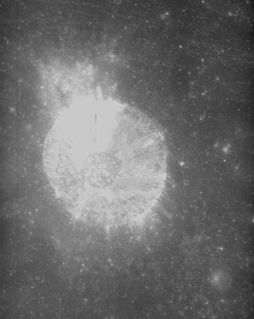
Cauchy is a small lunar impact crater on the eastern Mare Tranquillitatis. It was named after French mathematician Augustin-Louis Cauchy. It is circular and symmetric, with a small interior floor at the midpoint of the sloping inner walls. Due to the high albedo of this bowl-shaped formation, it is particularly prominent at full Moon.

Tacitus is a lunar impact crater located to the northwest of the crater Catharina, at the northern extension of the Rupes Altai ridge line. It was named after the 1st century Roman historian and writer Tacitus. Directly west is the crater Almanon, and to the northeast is Cyrillus. To the southeast of Tacitus is a long chain of craters named the Catena Abulfeda. This chain runs to the northwest from the eastern edge of the Rupes Altai, continuing for over 200 kilometers.
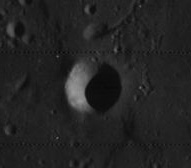
Toscanelli is a tiny, bowl-shaped lunar impact crater that is located to the north of the prominent crater Aristarchus, in the northwestern part of the Moon. The crater lies at the southern end of a rille that proceeds towards the north. This rille is part of a nearby system that has the designation Rimae Aristarchus. Just to the south of Toscanelli is a fault line in the surface named the Rupes Toscanelli, after the crater. This break in the surface continues to the south for a distance of about 70 kilometers.

Paolo dal Pozzo Toscanelli was an Italian mathematician, astronomer, and cosmographer.

Verona Rupes is a cliff on Miranda, a moon of Uranus. The cliff face, previously thought to be from 5 to 10 km high, as of 2016 is estimated to be 20 km (12 mi) high, which makes it the tallest known cliff in the Solar System.
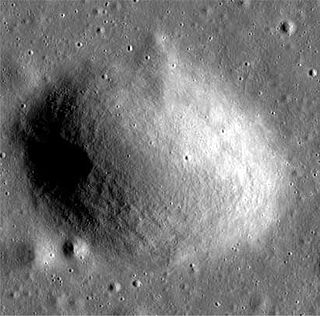
Donna is a tiny lunar crater on the near side of the Moon. Its name is an Italian female given name, and does not refer to a specific person. It is located in the eastern half of the Mare Tranquillitatis, at the summit of the lunar dome Omega (ω) Cauchy. As such domes are thought to be volcanic in nature, it appears likely that this crater was created by an eruption. This is in contrast to most lunar craters, which are now believed to be created by impacts. This crater is sufficiently small that it requires a large telescope to resolve.
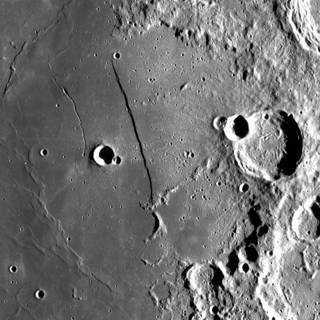
Rupes Recta is a linear fault on the Moon, in the southeastern part of the Mare Nubium at 22.1°S 7.8°W. The name is Latin for straight cliff, although it is more commonly called the Straight Wall. This is the most well-known escarpment on the Moon, and is a popular target for amateur astronomers.
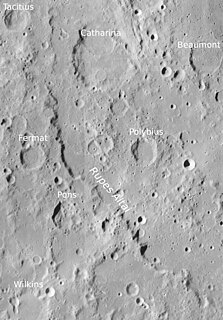
Rupes Altai is an escarpment in the lunar surface that is located in the southeastern quadrant of the Moon's near side. It is named for the Altai Mountains in Asia, and is the most prominent lunar escarpment. The selenographic coordinates of this feature are 24.3°S 22.6°E, and it has a length of about 427 km.
Rupes is the Latin word for 'cliff'. It is used in planetary geology to refer to escarpments on other worlds. As of January 2013, the IAU has named 62 such features in the Solar System, on Mercury (17), Venus (7), the Moon (8), Mars (23), the asteroids Vesta (2) and Lutetia (2), and Uranus's satellites Miranda (2) and Titania (1).

Rupes Cauchy is a 120 km-long escarpment at 9.0°N 37.0°E on the surface of the Moon. It faces southwest, and rises about 200–300 m. It is located in the northeastern portion of the Mare Tranquillitatis, and is named after the nearby crater Cauchy.

Rupes Kelvin is an escarpment near Promontorium Kelvin on the near side of the Moon, at 27.3°S 33.1°W. It is 86 km long. It takes its name from Promontorium Kelvin, which was named after the Irish scientist, physicist and engineer William Thomson, 1st Baron Kelvin.
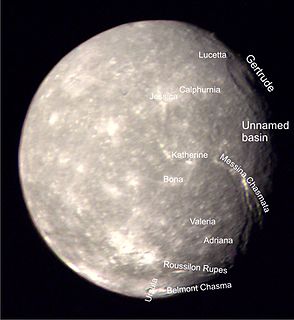
Rousillon Rupes is a scarp on the surface of the Uranian moon Titania named after "Bertram, count of Rousillon" in William Shakespeare's comedy All's Well That Ends Well. The 402 km long feature is a normal fault situated near the equator and running perpendicular to it. The scarp cuts impact craters, which probably means that it was formed at a relatively late stage of moon's evolution, when the interior of Titania expanded and its ice crust cracked as a result. Rousillon Rupes has only few crater superimposed on it, which also implies its relatively young age. The scarp was first imaged by Voyager 2 spacecraft in January 1986.

Rupes Boris is a short fault or ridge in the lunar surface that is located in the northwestern quadrant of the Moon's near side, within Mare Imbrium. Its name was adopted in 1985 by the International Astronomical Union, and was taken from the tiny nearby crater Boris. The selenographic coordinates of this feature are 30.5°N 33.5°W, and it has a length of just 4 km.

Rupes Tenuis is a Martian north polar scarp. It is named after one of the classical albedo features on Mars. Its name was officially approved by IAU in 1988. It extends from latitude 74.94°N to 82.2°N and from longitude 242.12°E to 300.77°E. Its centre is located at latitude 81.6°N longitude 85.47°W. It marks the outer perimeter of Planum Boreum from longitude 242.12°E to 300.77°E, and it is formed by the eastern extension of the Olympia Cavi, a series of local troughs and depressions, which become longer and deeper as they merge to create the Rupes Tenuis scarp formation. The scarp is located to the west of Chasma Boreale, at the base of Planum Boreum, and its height varies from a few hundred metres to a maximum of approximately 1000 metres.
The Rupes Mercator is an escarpment located on the Moon. It is named after the neighboring Mercator crater, a name assigned to it in 1935 by the International Astronomical Union in honor of the Flemish geographer and mathematician Gérard Mercator.
The Rupes Liebig is an escarpment located on the Moon. The cliff is named after the nearby Liebig crater, which in turn was named after the German chemist Justus von Liebig (1803–1873).
















